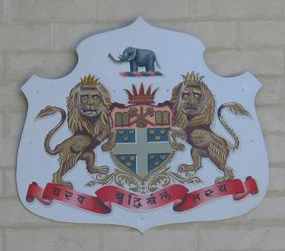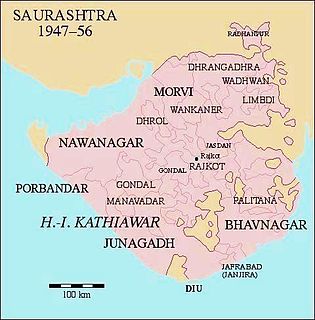
The Rajkumar College in Rajkot, Gujarat is one of the oldest K-12 institutions in India. RKC has a 26-acre campus in Rajkot.
Ramgarh Raj was a major Zamindari estate in the era of the British Raj, in the former Indian province of Bihar. The estate was ruled by Narain Dynasty. Territories which comprised the Ramgarh Raj presently constitute districts of Ramgarh, Hazaribagh, Chatra, Giridih, Koderma, and Bokaro with 3672 villages. The entire area is rich in minerals like coal and mica and falls under the Indian State of Jharkhand. The First King was Maharaja Baghdeo Singh and the last ruling king was Maharaja Kamakhya Narain Singh of this estate, until the estate was merged to the Republic of India. The revenue of the estate was about 3600000 and the ruling family was the first family in India to use helicopters in election campaigns.

Patan is a town in the Indian state of Rajasthan. In the 12th century, it became the centre of a minor state called Tanwarawati or Torawati, ruled by a Tomar family. Anangpall II, who established the city of Patan and ruled present day Delhi. Anangpall II, is considered to be a direct descendant of Raja Parikshit, Son of Abhimanyu and Grandson of Arjuna. (Pandavas)

Maj. Gen. HH Maharaja Sawai Shri Sir Man Singh II GCSI GCIE was the last ruling Maharaja of Jaipur State. He ruled the princely state between 1922 and 1949, when the state acceded unto the Dominion of India. Thereafter, he held office as Rajpramukh of Rajasthan between 1949 and 1956. In later life, he served as Ambassador of India to Spain. He was also a notable sportsman and celebrated polo player.

General Maharaja Sir Ganga Singh,, was the ruling Maharaja of the princely state of Bikaner from 1888 to 1943. As the only non-white member of the Imperial War Cabinet, he was present in the Palace of Versailles during The Signing of Peace in the Hall of Mirrors.

Idar State, also known as Edar, was a princely state that was located in present-day Gujarat state of India. During the British Raj era, it was a part of the Mahi Kantha Agency, within the Gujarat Division of Bombay Presidency.

Lieutenant-General Pratap Singh, was a career British Indian Army officer, Maharaja of the princely state of Idar (Gujarat) and heir to Ahmednagar later renamed as Himmatnagar from 1902 to 1911, when he abdicated in favour of his adopted son.
Daulat Singh was the Maharaja of Idar from 1911 to 1931.

Bharatpur State was a princely state in the Indian subcontinent. It was ruled by the Sinsinwar clan of the Hindu Jats. They claimed descent from Madan Pal, a Yaduvanshi Kshatriya.
Maharajadhiraj Mirza Maharao Sri Madansinhji Vijayaraji Sawai Bahadur was the last official ruler of Princely State of Cutch from 26 February 1948 to 1 June 1948.

Palitana was a princely state in India during the British Raj until 1948. The center was the city of Palitana. The last ruler of the state received a privy purse of 180,000 Rupees at the state's accession to independent India on 15 February 1948.
Raj Ratna was a title of high honor, a civilian award, which was prevalent in the princely states of India during the British Raj.

Maharaja Himmat Singhji was the last ruler of the princely state of Idar State. He was Maharaja of Idar from 1931 to 1948.

Baria State [The State of Baria], also known as Bariya State, was one of the princely states of India during the period of the British Raj. It was under the Rewa Kantha Agency of the Bombay Presidency and had its capital in Devgadh Baria town of present-day Dahod district in Gujarat state.
The line of succession to the former throne of Jodhpur, one of the pre-eminent Indian principalities, was by male primogeniture by the sons of Rajput mothers. Jodhpur State acceded to the Union of India in 1949.
The line of succession to the former throne of Rajpipla, one of the principal Indian salute states, was by male primogeniture. Ruled by the Gohil Rajput clan, the former Rajpipla State is now a constituent part of the Indian state of Gujarat.
Laiutenent Colonel Maharaj Kumar Dr. Basant Narain Singh was an Indian politician and a member of the 7th Lok Sabha representing Hazaribagh of Bihar State. He was regarded as the most prominent leader of Bihar at that time as throughout his life he never lost a single election. Did his M.R.A.S. (England), F.R.E.S., F.R.H.S. (London), M.A.M.N.H., M.N.G.S. (USA), educated at Rajkumar College, Raipur and at Mayo College, Ajmer. He belonged to the royal family of Ramgarh Raj and was from the Narain Dynasty.








